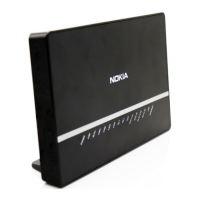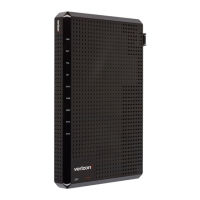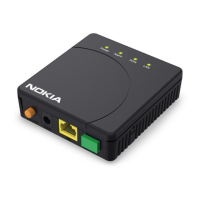Do you have a question about the Nokia IP390 - Security Appliance and is the answer not in the manual?
Describes the conventions, notices, and command-line elements used throughout the guide.
Lists other relevant Nokia and Check Point documentation for the IP390 appliance.
Provides a general overview of the IP390 appliance and its components.
Details the layout and status LEDs of the appliance's built-in Gigabit Ethernet ports.
Describes the two additional PMC network interface card (NIC) slots available on the appliance.
Explains how to monitor appliance and NIC operation via status LEDs on the front panel.
Outlines the methods for managing the IP390 appliance, including Network Voyager and CLI.
Lists essential requirements, warnings, and cautions to follow before installing the appliance.
Specifies the supported operating system and application requirements for the Nokia IP390 appliance.
Provides guidance on environmentally friendly disposal of the appliance and its components.
Lists the necessary tools and preparations required before installing the appliance.
Details the procedure for mounting the IP390 appliance into a standard 19-inch rack.
Explains how to connect the power supply to the IP390 appliance.
Guides users on establishing a serial console or modem connection for initial configuration.
Describes the use and pin assignments of the built-in console port for local management.
Explains the function and pin assignments of the auxiliary port for modem connections.
Details how to connect the appliance's network interfaces to the network.
Provides steps for performing initial configuration manually via a console connection.
Explains how to access and use Nokia Network Voyager for appliance configuration and monitoring.
Guides users on accessing Nokia IPSO documentation through the Network Voyager interface.
Describes how to manage and configure appliances using the Nokia IPSO command-line interface (CLI).
Outlines the use of Nokia Horizon Manager for secure software image and management tasks.
Details the four-port 10/100 Mbps Ethernet NIC, its features, and connections.
Lists the features supported by the Ethernet PMC NIC, such as traffic support and packet tracing.
Explains the RJ-45 connectors and the types of cables needed for Ethernet NIC connections.
Describes the two-port copper Gigabit Ethernet NIC, its features, and installation.
Lists the features of the copper Gigabit Ethernet NIC, including speed and bandwidth.
Details the RJ-45 connectors and cable requirements for copper Gigabit Ethernet NICs.
Covers the two-port fiber-optic Gigabit Ethernet NIC, its features, and connections.
Lists the features of fiber-optic Gigabit Ethernet NICs, including bandwidth and compliance.
Explains cable types and connectors for fiber-optic Gigabit Ethernet NICs.
Provides instructions for installing or removing SFP modules for fiber-optic NICs.
Details the four-port T1 NIC, its features, and connections for T1 circuits.
Lists the features of the T1 NIC, including throughput and deployment context.
Explains the RJ-48 connectors and cable requirements for T1 NIC connections.
Explains how to deactivate NIC interfaces using Network Voyager before removal.
Provides step-by-step instructions for removing, installing, and replacing network interface cards.
Details how to configure and activate newly installed or replaced network interfaces.
Describes how to assess the operational status of NICs by checking their LED indicators.
Guides users on how to replace the compact flash memory card containing the operating system.
Explains how to install a flash-memory PC card for storing logs, images, and configuration files.
Details copying configuration files between internal flash and an optional flash-memory PC card.
Covers adding or replacing a hard-disk drive for flash-based IP390 appliances.
Explains how to configure an optional hard-disk drive for storing log files locally.
Provides instructions for upgrading or replacing the appliance's memory modules (DIMMs).
Details the procedure for replacing the internal battery of the IP390 appliance.
Provides tips for resolving non-routing related problems with the IP390 appliance.
Addresses issues with establishing a console connection and logging into the appliance.
Offers solutions for problems where the login prompt appears but the password is not accepted.
Provides troubleshooting steps when no login prompt appears and error messages are displayed.
Resolves connectivity issues when Network Voyager access fails but console access is functional.
Addresses scenarios where expected network interfaces are not detected or displayed.
Covers common issues related to Ethernet connectivity and attached devices, like link lights.
Solves problems related to pinging or connectivity between different ports on the appliance.
Discusses troubleshooting common issues encountered with multicast traffic and protocols.
Addresses specific problems when interfacing with 1483 devices, including VC/VP values and encapsulation.
Troubleshoots issues where the appliance is not receiving power, checking cords and power sources.
Provides solutions for when the appliance fails to recognize newly installed memory modules.
Solves appliance lock-ups post-IPSO upgrade, focusing on boot manager settings.
Introduces tools and methods for diagnosing and resolving routing issues on the appliance.
Details common issues and solutions related to the OSPF routing protocol.
Covers common problems and solutions for the RIP routing protocol.
Addresses issues encountered when exchanging routes between different routing protocols.
Lists the physical dimensions of the Nokia IP390 appliance, including height, width, and depth.
Specifies the rack space and clearance needed for proper installation and ventilation of the appliance.
States the acceptable operating temperature range for the Nokia IP390 appliance.
Provides details on the types of NIC interfaces, cable types, and connectors used with the appliance.
States that the product conforms to applicable safety and EMC standards as per ISO/IEC 17050.
Lists the specific emissions, immunity, and harmonics standards the hardware complies with.
Details the standards related to electromagnetic emissions compliance for the device.
Lists the standards related to electromagnetic immunity compliance for the device.
Specifies compliance with standards related to power quality and harmonics.
Outlines specific FCC rules and requirements for the device, including registration and installation.
Provides FCC test results and compliance notices for the device as a Class A digital device.
Describes the conventions, notices, and command-line elements used throughout the guide.
Lists other relevant Nokia and Check Point documentation for the IP390 appliance.
Provides a general overview of the IP390 appliance and its components.
Details the layout and status LEDs of the appliance's built-in Gigabit Ethernet ports.
Describes the two additional PMC network interface card (NIC) slots available on the appliance.
Explains how to monitor appliance and NIC operation via status LEDs on the front panel.
Outlines the methods for managing the IP390 appliance, including Network Voyager and CLI.
Lists essential requirements, warnings, and cautions to follow before installing the appliance.
Specifies the supported operating system and application requirements for the Nokia IP390 appliance.
Provides guidance on environmentally friendly disposal of the appliance and its components.
Lists the necessary tools and preparations required before installing the appliance.
Details the procedure for mounting the IP390 appliance into a standard 19-inch rack.
Explains how to connect the power supply to the IP390 appliance.
Guides users on establishing a serial console or modem connection for initial configuration.
Describes the use and pin assignments of the built-in console port for local management.
Explains the function and pin assignments of the auxiliary port for modem connections.
Details how to connect the appliance's network interfaces to the network.
Provides steps for performing initial configuration manually via a console connection.
Explains how to access and use Nokia Network Voyager for appliance configuration and monitoring.
Guides users on accessing Nokia IPSO documentation through the Network Voyager interface.
Describes how to manage and configure appliances using the Nokia IPSO command-line interface (CLI).
Outlines the use of Nokia Horizon Manager for secure software image and management tasks.
Details the four-port 10/100 Mbps Ethernet NIC, its features, and connections.
Lists the features supported by the Ethernet PMC NIC, such as traffic support and packet tracing.
Explains the RJ-45 connectors and the types of cables needed for Ethernet NIC connections.
Describes the two-port copper Gigabit Ethernet NIC, its features, and installation.
Lists the features of the copper Gigabit Ethernet NIC, including speed and bandwidth.
Details the RJ-45 connectors and cable requirements for copper Gigabit Ethernet NICs.
Covers the two-port fiber-optic Gigabit Ethernet NIC, its features, and connections.
Lists the features of fiber-optic Gigabit Ethernet NICs, including bandwidth and compliance.
Explains cable types and connectors for fiber-optic Gigabit Ethernet NICs.
Provides instructions for installing or removing SFP modules for fiber-optic NICs.
Details the four-port T1 NIC, its features, and connections for T1 circuits.
Lists the features of the T1 NIC, including throughput and deployment context.
Explains the RJ-48 connectors and cable requirements for T1 NIC connections.
Explains how to deactivate NIC interfaces using Network Voyager before removal.
Provides step-by-step instructions for removing, installing, and replacing network interface cards.
Details how to configure and activate newly installed or replaced network interfaces.
Describes how to assess the operational status of NICs by checking their LED indicators.
Guides users on how to replace the compact flash memory card containing the operating system.
Explains how to install a flash-memory PC card for storing logs, images, and configuration files.
Details copying configuration files between internal flash and an optional flash-memory PC card.
Covers adding or replacing a hard-disk drive for flash-based IP390 appliances.
Explains how to configure an optional hard-disk drive for storing log files locally.
Provides instructions for upgrading or replacing the appliance's memory modules (DIMMs).
Details the procedure for replacing the internal battery of the IP390 appliance.
Provides tips for resolving non-routing related problems with the IP390 appliance.
Addresses issues with establishing a console connection and logging into the appliance.
Offers solutions for problems where the login prompt appears but the password is not accepted.
Provides troubleshooting steps when no login prompt appears and error messages are displayed.
Resolves connectivity issues when Network Voyager access fails but console access is functional.
Addresses scenarios where expected network interfaces are not detected or displayed.
Covers common issues related to Ethernet connectivity and attached devices, like link lights.
Solves problems related to pinging or connectivity between different ports on the appliance.
Discusses troubleshooting common issues encountered with multicast traffic and protocols.
Addresses specific problems when interfacing with 1483 devices, including VC/VP values and encapsulation.
Troubleshoots issues where the appliance is not receiving power, checking cords and power sources.
Provides solutions for when the appliance fails to recognize newly installed memory modules.
Solves appliance lock-ups post-IPSO upgrade, focusing on boot manager settings.
Introduces tools and methods for diagnosing and resolving routing issues on the appliance.
Details common issues and solutions related to the OSPF routing protocol.
Covers common problems and solutions for the RIP routing protocol.
Addresses issues encountered when exchanging routes between different routing protocols.
Lists the physical dimensions of the Nokia IP390 appliance, including height, width, and depth.
Specifies the rack space and clearance needed for proper installation and ventilation of the appliance.
States the acceptable operating temperature range for the Nokia IP390 appliance.
Provides details on the types of NIC interfaces, cable types, and connectors used with the appliance.
States that the product conforms to applicable safety and EMC standards as per ISO/IEC 17050.
Lists the specific emissions, immunity, and harmonics standards the hardware complies with.
Details the standards related to electromagnetic emissions compliance for the device.
Lists the standards related to electromagnetic immunity compliance for the device.
Specifies compliance with standards related to power quality and harmonics.
Outlines specific FCC rules and requirements for the device, including registration and installation.
Provides FCC test results and compliance notices for the device as a Class A digital device.
| Product Type | Security Appliance |
|---|---|
| Manufacturer | Nokia |
| Model | IP390 |
| Form Factor | Rack-mountable |
| Operating System | Nokia IPSO |
| Processor | Intel |
| Interfaces | Serial |
| VPN Support | IPSec |
| Power Supply | AC 100-240V |
| Dimensions (H x W x D) | 1.75 x 17.5 in |











